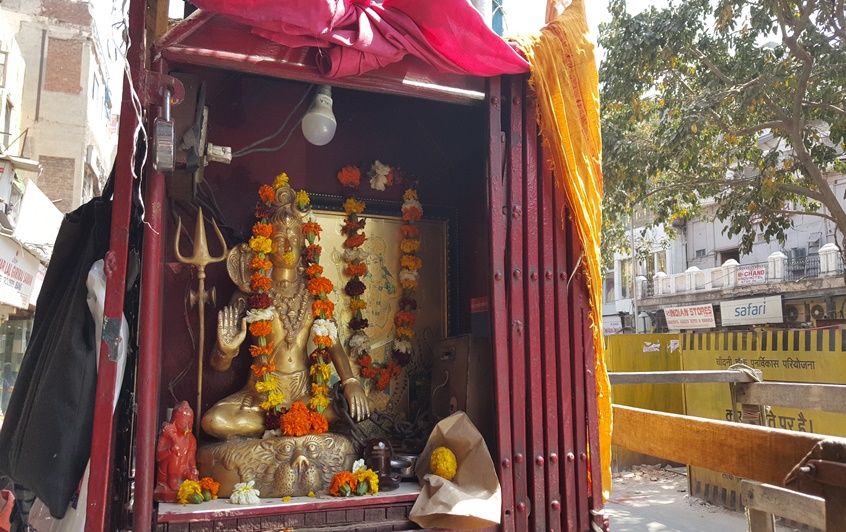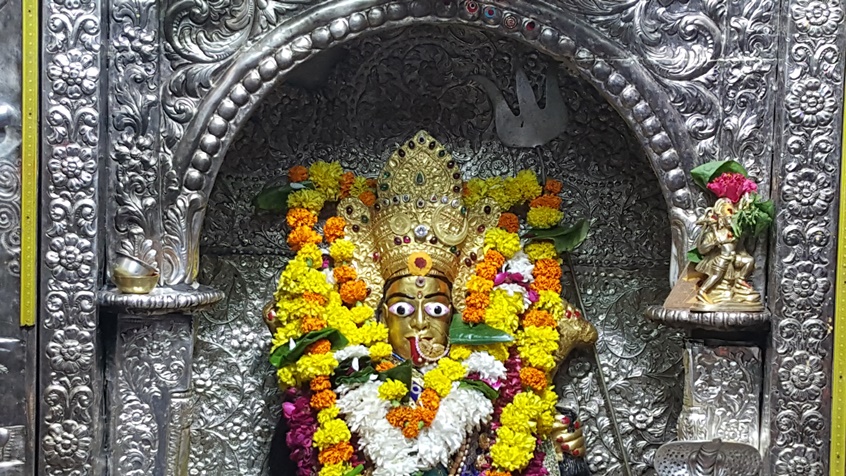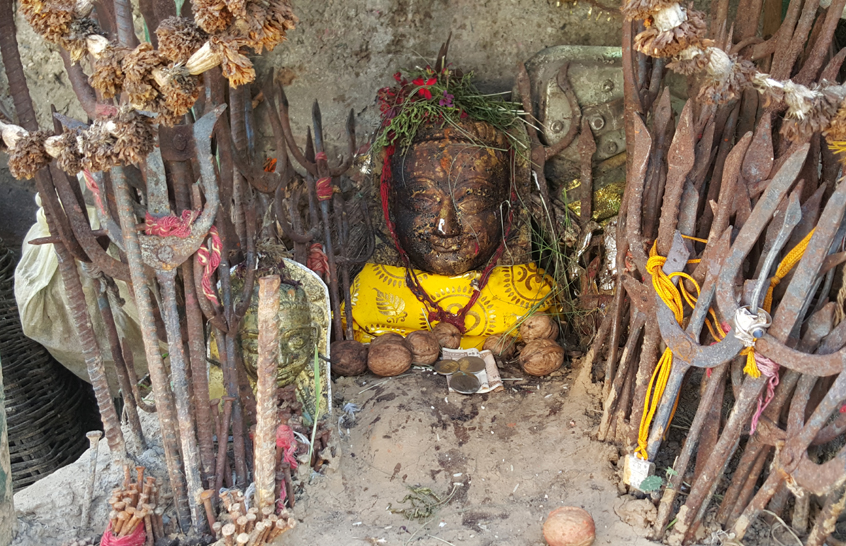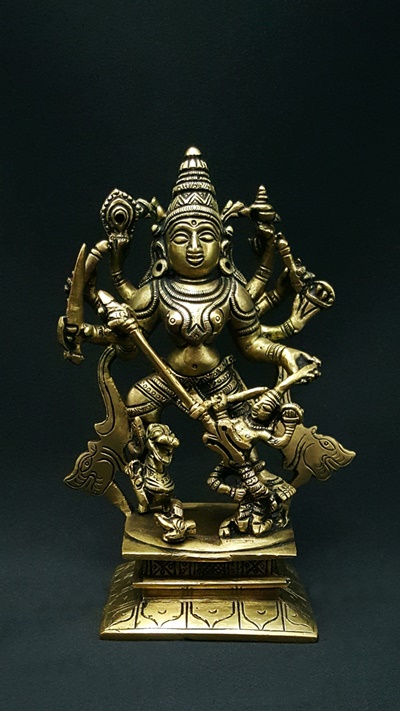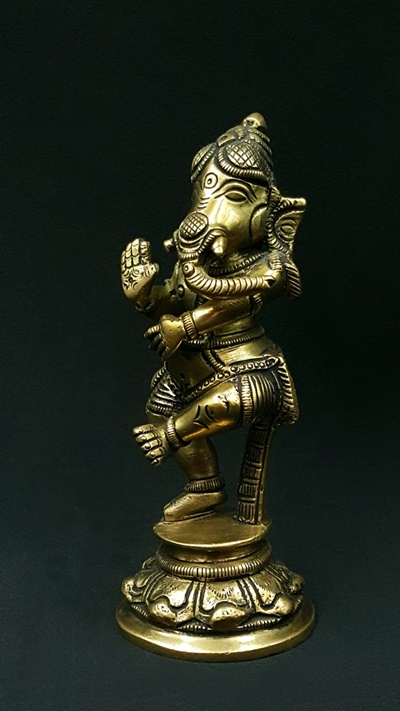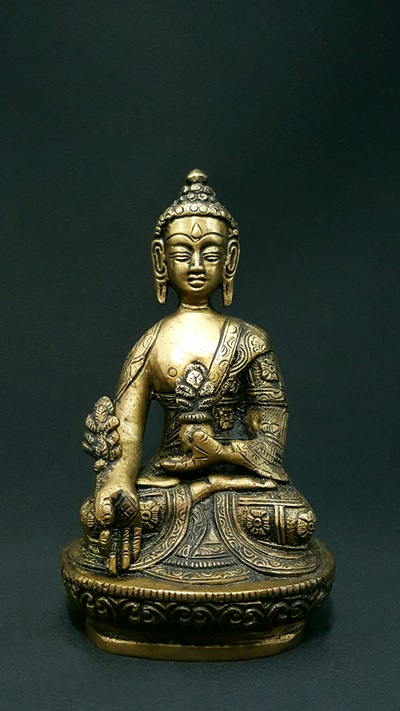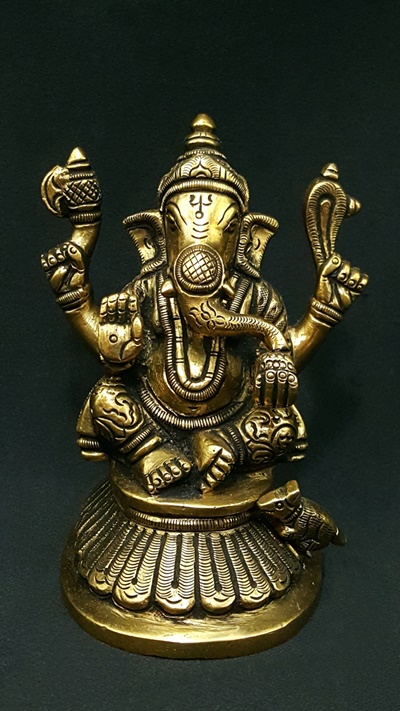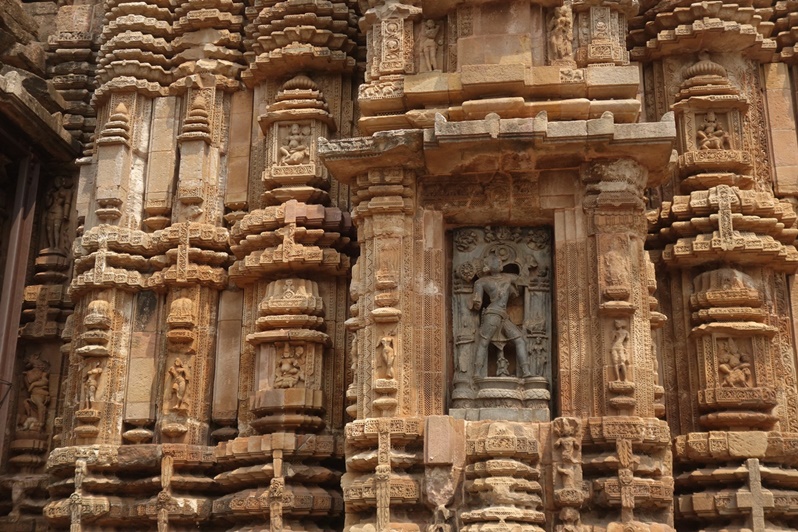
par Bertrand Bellaize, le 05 avril 2020
Art sacré hindou : statue indienne, le message des postures
L’art sacré hindou sert de nourriture spirituelle, accessible à tous : il peut posséder un pouvoir de transformation. L’important dans la représentation d’un divinité en Inde, ce n’est pas la ressemblance avec la réalité mais le message qui est transmis à travers cette image sacrée.
La posture générale de la divinité va tout de suite nous donner une information précieuse sur le message transmis par la forme manifestée du divin. Les divinités principales, celle de la Trimurti (surtout Vishnou et Shiva et leur Shakti Lakshmi et Parvati) ainsi que Krishna, Ganesh entre autres prennent des noms et des formes différentes correspond à l’enseignement transmis.
Shiva, Mahayogi, ou Shiva sous la forme de Pashupati, le gardien des troupeaux n’ont pas du tout le même rôle didactique, ni donc la même représentation.
La divinité peut donc apparaître debout, sur ses 2 pieds ou en équilibre sur une jambe, ou encore assise, en lotus, demi lotus… voire même allongée. Dès le premier abord une impression se dégage : posture détendue, combative, courroucée, apaisante ou méditative ?
Samabhanga soit sans flexion : les jambes, debout, sont tendues. L’ensemble de la statue dégage alors une impression de parfait équilibre, de droiture. Une variante, Sthânu, le pilier, qui signifie aussi l’immuable : cette posture est utilisée montrant Shiva, yogi, ascète en méditation profonde, en immersion dans l’absolu.
Abhanga soit avec une seule flexion : les pieds reposent sur le sol, une des jambes est en légère flexion, avec la hanche saillante. Le poids du corps repose sur la jambe tendue : cette posture indique que la divinité est dans une activité de profonde réflexion.
Cette position peut évoluer vers Dvibhanga ou Tribhanga qui implique pour l’une, 2 flexions (jambe et hanche) et l’autre 3 flexions (hanche, épaule et cou) et indique une attitude bienveillante mais elle peut aussi, notamment dans les danses, souligner la grâce, la sensualité (voir les statues des temples de Khajuraho).
Par contre l’Atibhanga, soit flexions excessives, indique un mouvement vif voir violent (Shiva dans des formes destructrices) et est utilisé dans la sculpture de Shiva Nataraja, ou pour représenter Krishna dansant, indiquant le mouvement perpétuel qui anime la vie.
Padasvastika : les jambes sont croisées, le poids du corps est supporté par une seule jambe, pied bien au sol tandis que la jambe légèrement fléchie repose sur la pointe du pied. C’est la posture souvent prise par Krishna jouant de la flûte (Venugopala), elle marque la détente, la divine sérénité.
Alidhapada : position de l’archer : pieds plaqués au sol, une des jambes est fléchie, genou plié tandis que l’autre se tient tendue vers l’arrière. Le buste est légèrement avancé. C’est bien entendu une position qui implique l’action, une attitude combative. elle montre la divinité à l’occasion d’un bataille tel Durga Mahishasuramardini terrassant le démon buffle. Cette position peut se retrouver jambe gauche tendue et inversement.
Nrityamurti qui représente une divinité lorsqu'elle danse : par exemple Ganesh se tient sur une seule jambe légèrement fléchie tandis que le pied de l'autre est proche du genou. Ganesh danse comme son père Shiva : une danse cosmique qui symbolise le changement, le mouvement qui ne cesse de se produire à tout instant même si nous le percevons pas (mais que les physiciens nous prouvent aisément aujourd'hui).
Padmâsana : la plus célèbre, la position du lotus : Padma signifie lotus. Elle symbolise la méditation, un état d’intériorisation profonde..
Virâsana soit la posture du héros : elle se présente sous différentes formes. Dans la pratique du yoga, bien souvent les fesses reposent sur le plat des pieds, les genoux pliés devant mais dans les statues, la divinité en plutôt en demi lotus (un des 2 pieds repose sur le sol).
Yogâsana soit les postures (âsana) de yoga : à la différence de Padmâsana, les pieds reposent au sol, genoux relevés (les mains peuvent reposer sur les genoux). Cette posture est utilisée par les divinités représentées en tant que Yogi ou ascète, c’est bien souvent le cas de Shiva. En fonction des autres caractéristiques de la statue, elle va pointer vers un aspect plus particulier de la recherche spirituelle (geste des mains, attributs…).
Sattvaparyaṅka : l’attitude noble : à la différence de Padmâsana, les deux pieds reposent sur le sol. Le dos est bien droit
Sattvāsana : c’est le symbole de l’attention à autrui : les pieds sont croisés au niveau des chevilles, le pied droit est situé devant.
Maharajalîlâsana : la divinité est assise, la jambe gauche repliée (telle la position de lotus) tandis que la droite est redressée, genou plié, la main ou le coude reposant dessus. C’est la position décontractée par excellence, d’ »aise royale ».
Lalitâsana avec jambe gauche pendante ou jambe droite pendante : position de sérénité.
Posture avec les 2 jambes pendantes, pralambapāsana, assise à l’européenne, indique que la divinité est en état de profonde contemplation.
Enfin et plus rarement, les divinités peuvent prendre la position couchée tel Vishnou, immobile à la surface de l’océan primordial : sous cette forme (Narayana), il représente les forces latentes, l’état non manifesté, l’absolu.
Il est donc intéressant de noter que la seule posture nous donne déjà de nombreuses indications sur le sens métaphysique de la statue : contemplative (intériorisation, cheminement spirituel….), message de bienveillance, de protection (sérénité, détente….), d’action (mouvement,combat, posture du héros…).
Sources
The Book of Hindu Imagery: Gods, Manifestations and Their Meaning : Eva Rudy Janssen
Un et multiple : Sarah Combe
Mythes et dieux de l’Inde : Alain Danielou
Petite Encyclopédie des Divinités et Symboles du Bouddhisme Tibétain, Tcheuky Sèngué
La posture générale de la divinité va tout de suite nous donner une information précieuse sur le message transmis par la forme manifestée du divin. Les divinités principales, celle de la Trimurti (surtout Vishnou et Shiva et leur Shakti Lakshmi et Parvati) ainsi que Krishna, Ganesh entre autres prennent des noms et des formes différentes correspond à l’enseignement transmis.
Shiva, Mahayogi, ou Shiva sous la forme de Pashupati, le gardien des troupeaux n’ont pas du tout le même rôle didactique, ni donc la même représentation.
La divinité peut donc apparaître debout, sur ses 2 pieds ou en équilibre sur une jambe, ou encore assise, en lotus, demi lotus… voire même allongée. Dès le premier abord une impression se dégage : posture détendue, combative, courroucée, apaisante ou méditative ?
LES POSITIONS DEBOUT
Les positions debout statiques
Samabhanga soit sans flexion : les jambes, debout, sont tendues. L’ensemble de la statue dégage alors une impression de parfait équilibre, de droiture. Une variante, Sthânu, le pilier, qui signifie aussi l’immuable : cette posture est utilisée montrant Shiva, yogi, ascète en méditation profonde, en immersion dans l’absolu.
Abhanga soit avec une seule flexion : les pieds reposent sur le sol, une des jambes est en légère flexion, avec la hanche saillante. Le poids du corps repose sur la jambe tendue : cette posture indique que la divinité est dans une activité de profonde réflexion.
Cette position peut évoluer vers Dvibhanga ou Tribhanga qui implique pour l’une, 2 flexions (jambe et hanche) et l’autre 3 flexions (hanche, épaule et cou) et indique une attitude bienveillante mais elle peut aussi, notamment dans les danses, souligner la grâce, la sensualité (voir les statues des temples de Khajuraho).
Par contre l’Atibhanga, soit flexions excessives, indique un mouvement vif voir violent (Shiva dans des formes destructrices) et est utilisé dans la sculpture de Shiva Nataraja, ou pour représenter Krishna dansant, indiquant le mouvement perpétuel qui anime la vie.
Padasvastika : les jambes sont croisées, le poids du corps est supporté par une seule jambe, pied bien au sol tandis que la jambe légèrement fléchie repose sur la pointe du pied. C’est la posture souvent prise par Krishna jouant de la flûte (Venugopala), elle marque la détente, la divine sérénité.
Les positions debout dynamiques
Alidhapada : position de l’archer : pieds plaqués au sol, une des jambes est fléchie, genou plié tandis que l’autre se tient tendue vers l’arrière. Le buste est légèrement avancé. C’est bien entendu une position qui implique l’action, une attitude combative. elle montre la divinité à l’occasion d’un bataille tel Durga Mahishasuramardini terrassant le démon buffle. Cette position peut se retrouver jambe gauche tendue et inversement.
Nrityamurti qui représente une divinité lorsqu'elle danse : par exemple Ganesh se tient sur une seule jambe légèrement fléchie tandis que le pied de l'autre est proche du genou. Ganesh danse comme son père Shiva : une danse cosmique qui symbolise le changement, le mouvement qui ne cesse de se produire à tout instant même si nous le percevons pas (mais que les physiciens nous prouvent aisément aujourd'hui).
LES POSITIONS ASSISES
Postures avec les 2 jambes repliées
Padmâsana : la plus célèbre, la position du lotus : Padma signifie lotus. Elle symbolise la méditation, un état d’intériorisation profonde..
Virâsana soit la posture du héros : elle se présente sous différentes formes. Dans la pratique du yoga, bien souvent les fesses reposent sur le plat des pieds, les genoux pliés devant mais dans les statues, la divinité en plutôt en demi lotus (un des 2 pieds repose sur le sol).
Yogâsana soit les postures (âsana) de yoga : à la différence de Padmâsana, les pieds reposent au sol, genoux relevés (les mains peuvent reposer sur les genoux). Cette posture est utilisée par les divinités représentées en tant que Yogi ou ascète, c’est bien souvent le cas de Shiva. En fonction des autres caractéristiques de la statue, elle va pointer vers un aspect plus particulier de la recherche spirituelle (geste des mains, attributs…).
Sattvaparyaṅka : l’attitude noble : à la différence de Padmâsana, les deux pieds reposent sur le sol. Le dos est bien droit
Sattvāsana : c’est le symbole de l’attention à autrui : les pieds sont croisés au niveau des chevilles, le pied droit est situé devant.
Postures avec 1 seule jambe repliée
Maharajalîlâsana : la divinité est assise, la jambe gauche repliée (telle la position de lotus) tandis que la droite est redressée, genou plié, la main ou le coude reposant dessus. C’est la position décontractée par excellence, d’ »aise royale ».
Lalitâsana avec jambe gauche pendante ou jambe droite pendante : position de sérénité.
Posture avec les 2 jambes pendantes, pralambapāsana, assise à l’européenne, indique que la divinité est en état de profonde contemplation.
Enfin et plus rarement, les divinités peuvent prendre la position couchée tel Vishnou, immobile à la surface de l’océan primordial : sous cette forme (Narayana), il représente les forces latentes, l’état non manifesté, l’absolu.
Il est donc intéressant de noter que la seule posture nous donne déjà de nombreuses indications sur le sens métaphysique de la statue : contemplative (intériorisation, cheminement spirituel….), message de bienveillance, de protection (sérénité, détente….), d’action (mouvement,combat, posture du héros…).
Sources
The Book of Hindu Imagery: Gods, Manifestations and Their Meaning : Eva Rudy Janssen
Un et multiple : Sarah Combe
Mythes et dieux de l’Inde : Alain Danielou
Petite Encyclopédie des Divinités et Symboles du Bouddhisme Tibétain, Tcheuky Sèngué
Réagissez à cet article
Posté le 02 janvier 2021 à 12h39 par Ganesh Art India
Les postures couchées sont rares : en effet, elles représentent l'aspect passif, la conscience non manifestée.
Ils existent cependant deux exceptions majeures :
- Le Bouddha dans la position de Parinivanasana, soit le Bouddha entrant dans le Nirvana
- Vishnou Narayana : Vishnou représente alors l’état latent avant la manifestation : il dort, Nârâyana signifie « reposant sur les eaux », dans le laps de temps qui se déroule entre deux mondes. Le serpent « Vestige » sur lequel il repose flotte sur les eaux primordiales. Vestige symbolise la nature non manifestée, le stade premier de la Conscience.
Posté le 26 décembre 2020 à 03h46 par Daniel
Et les postures couchées. Que symbolisent-elles ?
